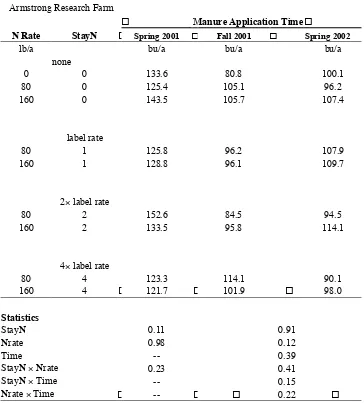Iowa State University
Digital Repository @ Iowa State University
Iowa State Research Farm Progress Reports Iowa State University Research and Demonstration
Farms
2002
Corn Yield Response to Application of Swine
Manure and Stay-N
Randy Killorn
Iowa State University
Kyle Jensen
Iowa State University
Follow this and additional works at:htp://lib.dr.iastate.edu/farms_reports
Part of theAgricultural Science Commons,Agriculture Commons, and theAgronomy and Crop Sciences Commons
his report is brought to you for free and open access by the Iowa State University Research and Demonstration Farms at Digital Repository @ Iowa State University. It has been accepted for inclusion in Iowa State Research Farm Progress Reports by an authorized administrator of Digital Repository @ Iowa State University. For more information, please contacthinefuku@iastate.edu.
Recommended Citation
Killorn, Randy and Jensen, Kyle, "Corn Yield Response to Application of Swine Manure and Stay-N" (2002).Iowa State Research Farm Progress Reports.Paper 1440.
Iowa State University, Armstrong Research and Demonstration Farm ISRF02-12
Corn Yield Response to Application of Swine
Manure and Stay-N
Randy Killorn, professor Kyle Jensen, research assistant
Department of Agronomy
Introduction
As a result of intensive livestock production in Iowa, large quantities of manure are being produced. Research is needed to evaluate the best way to use this resource. Swine manure contains many nutrients that are essential for plant growth, especially nitrogen (N). A nitrification inhibitor (Stay-N) was used to reduce the rate of conversion of NH4
+
to NO3
to lessen the potential of leaching losses. The objective of this experiment was to identify the optimum manure rate and determine whether the addition of Stay-N is practical.
Materials and Methods
The experiment was arranged in a randomized, complete block design replicated four times. Treatments were arranged in a factorial design of manure and Stay-N. Manure was applied at three different rates so that the nitrogen added was 0, 80, and 160 lb/acre. Stay-N rates were 0, label rate, twice label rate, and four times label rate. Treatments were applied at two different times for the same growing season in the second year, fall 2001 after harvest and spring 2002 before planting. The treatments were applied to 10’ ¥ 40’ plots with a small manure applicator. The applicator uses three knifes to inject manure between the rows. After treatments were
applied, the plots were tilled again that same day to create a suitable seedbed. Plant samples from each plot were taken at physiological maturity, and the ears were removed and tested for total N. Grain was mechanically harvested and used to determine yield and total N content. Harvest results from this experiment are shown in Table 1.
Results and Discussion
Yields for the two years of the experiment are listed in Table 1. The average yield was higher in 2001 because of sufficient precipitation; low yields in 2002 were related to inadequate precipitation. The no-manure treatment in both years seemed to have very respectable yields (spring 2001, 133.6 bushels/acre; fall 2001, 80.8 bushels/acre; and spring 2002, 100.1
bushels/acre) for not having any nitrogen added, suggesting the fertility level of the soil was sufficient in N to grow corn. Analysis of the swine manure used was done after application and resulted in more N applied than originally calculated. The actual N applied to plots was 127 lb N/a and 254 lb N/a.
In 2001 Stay-N response was significant (p>F=0.11). Twice the label rate yielded the highest. Untreated plots, those that received label rate, and four times label rate yielding less. This may have been due to random chance or due to negative response to Stay-N at the highest rate (four times label rate). In 2002 Stay-N response was not significant but there was a response to manure. The high rate of manure yielded more on average than did the low rate.
Data are still being analyzed, but our preliminary conclusion is that more study is required before recommendations concerning the use of Say-N with animal manure can be made.
Acknowledgments
Iowa State University, Armstrong Research and Demonstration Farm ISRF02-12
Table 1. Corn yield response to manure and Stay-N nitrification inhibitor.
Armstrong Research Farm
! Manure Application Time!
N Rate StayN ! Spring 2001 ! Fall 2001 ! Spring 2002
lb/a bu/a bu/a bu/a
none
0 0 133.6 80.8 100.1
80 0 125.4 105.1 96.2
160 0 143.5 105.7 107.4
label rate
80 1 125.8 96.2 107.9
160 1 128.8 96.1 109.7
2¥ label rate
80 2 152.6 84.5 94.5
160 2 133.5 95.8 114.1
4¥ label rate
80 4 123.3 114.1 90.1
160 4 ! 121.7 ! 101.9 ! 98.0
Statistics
StayN 0.11 0.91
Nrate 0.98 0.12
Time -- 0.39
StayN ¥ Nrate 0.23 0.41
StayN ¥ Time -- 0.15
